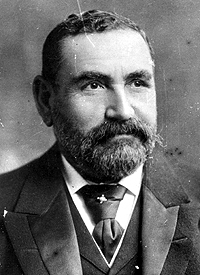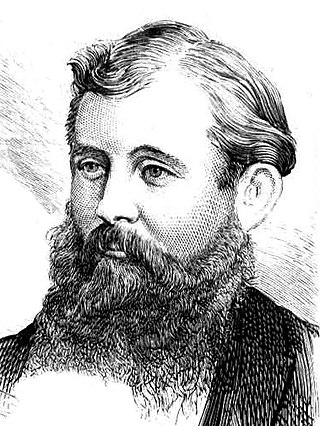Related Research Articles
Macquarie, until 1910 The Macquarie was an electoral district of the Legislative Assembly in the Australian state of New South Wales, created in 1894 and named after the Macquarie River. It was re-created in 1904, retaining nothing but the name, then abolished in 1920.

Sir George Stephenson Beeby KBE was an Australian politician, judge and author. He was one of the founders of the Labor Party in New South Wales, and represented the party in state parliament from 1907 to 1912. He fell out with the party and later served as an independent, a Nationalist, and a Progressive. He left parliament in 1920 to join the state arbitration court, and in 1926 was appointed to the Commonwealth Court of Conciliation and Arbitration. He was Chief Judge from 1939 until his retirement in 1941.
Members of the New South Wales Legislative Assembly who served in the eighth parliament of New South Wales held their seats from 1874 to 1877. The 1874–75 election was held between 8 December 1874 and 12 January 1875 with parliament first meeting on 27 January 1875. There were 72 members elected for 52 single member electorates, 6 two member electorates and 2 four member electorates. During this parliament the number of graduates of Sydney University exceeded 100 and the seat of University of Sydney was created. The maximum term of this parliament was 3 years and the assembly was dissolved after 34 months. Premiers during this parliament were Sir John Robertson 9 February 1875 till 22 March 1877 and from 17 August 1877 and Sir Henry Parkes 22 March 1877 till 17 August 1877. The Speaker was William Arnold until his death on 1 March 1875 and then George Allen.

Daniel O'Connor was an Irish-born politician and businessman active in colonial-era New South Wales.
Joseph Michael Leary, was an Australian politician and solicitor, serving as a member of the New South Wales Legislative Assembly.
John Ryan Brenan was an Australian politician and an elected member of the New South Wales Legislative Assembly for 68 days in 1856. He founded, and outlined, the suburb of Smithfield in Sydney. Furthermore, Brenan Park, which is in that suburb, was named after him.

The See ministry was the 30th ministry of the New South Wales Government, and was led by the 14th Premier, Sir John See. The title of Premier was widely used to refer to the Leader of Government, but was not a formal position in the government until 1920. Instead the Premier was appointed to another portfolio, usually Colonial Secretary.

John Stuart Hawthorne was an Australian politician.

The Electoral district of Port Phillip was an electorate of the New South Wales Legislative Council before it became the separate colony of Victoria (Australia) on 1 July 1851. At the time, some members of the Council were elected and the balance were appointed by the Governor. The Town of Melbourne returned one member while the Port Phillip district, which covered the rest of what became Victoria after its separation in 1851, returned five members.

John Fitzgerald Burns was an Australian politician, member of the Parliament of New South Wales, Postmaster-General in the 1870s and Colonial Treasurer in the 1880s.

John Hurley was a politician in colonial Australia, a member at different times of the New South Wales Legislative Assembly and the Queensland Legislative Assembly.
This is a list of members of the New South Wales Legislative Council from 1843 to 1851. The 1843 Electoral Act prescribed 36 members, 24 to be elected, 6 appointed by virtue of their office and 6 nominated. The appointments and elections were for five year terms and thus occurred in 1843, and 1848. The Speaker was Alexander Macleay until 19 May 1846 and then Charles Nicholson. The parliament was dissolved on 30 June 1851 as a result of the 1851 Electoral Act which increased the number of members in the Council to 54.
Frederick Jamison Gibbes was an Australian politician.

Harman John Tarrant was an Irish-born Australian surgeon and politician.

John Wetherspoon was a Scottish-born farmer and politician in New South Wales, Australia.
A by-election was held for the New South Wales Legislative Assembly electorate of Mudgee on 6 January 1879 because of the resignation of Sir John Robertson who was then appointed to the Legislative Council, to facilitate the coalition of his supporters and those of Sir Henry Parkes to form an effective government.
A by-election was held for the New South Wales Legislative Assembly electorate of Upper Hunter on 3 July 1868 due to the resignation of sitting member James White, who left the colony to travel to England, Europe and the United States.
A by-election was held for the New South Wales Legislative Assembly electorate of West Sydney on 26 July 1890 because of the death of Alfred Lamb.
A by-election was held for the New South Wales Legislative Assembly electorate of Balmain on 10 July 1890 because John Hawthorne resigned due to bankruptcy.
A by-election for the seat of St Leonards in the New South Wales Legislative Assembly was held on 4 June 1885 because of the death of Bernhardt Holtermann.
References
- ↑ Rutledge, Martha. "Hurley, John (1844–1911)". Australian Dictionary of Biography . Canberra: National Centre of Biography, Australian National University. ISBN 978-0-522-84459-7. ISSN 1833-7538. OCLC 70677943 . Retrieved 8 December 2019.
- 1 2 "Mr John Hurley (2) (1844-1911)". Former members of the Parliament of New South Wales . Retrieved 5 May 2019.
- ↑ "In bankruptcy: re John Hurley". New South Wales Government Gazette . No. 372. 11 July 1890. p. 5378. Retrieved 28 April 2021– via Trove.
- ↑ "Writ of election: Hartley". New South Wales Government Gazette . No. 356. 4 July 1890. p. 5203. Retrieved 24 September 2020– via Trove.
- ↑ Green, Antony. "1890 Hartley by-election". New South Wales Election Results 1856-2007. Parliament of New South Wales . Retrieved 17 October 2019.